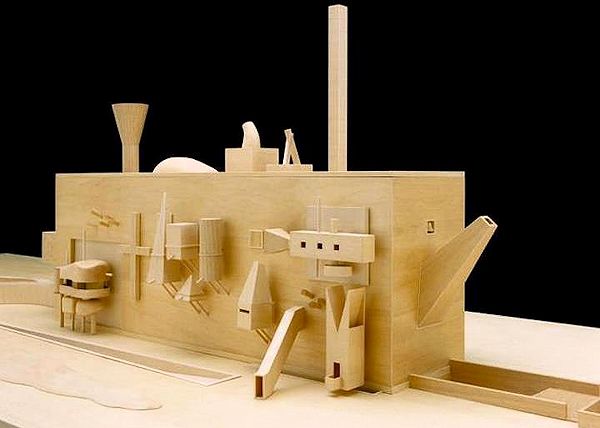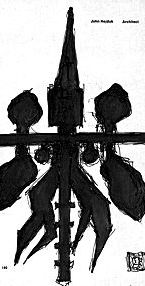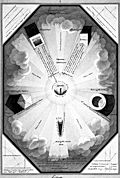2014.07.11 16:42
Art + Architecture: Schumacher vs. Post-Net
And a book that I'm presently dissecting (literally) to discovery the full workings of it's 'anatomy' is Hejduk's Pewter Wings, Golden Horns, Stone Veils.
2014.07.14 14:20
religious architecture by non-religious architects
I'm not sure if John Hejduk became more religious toward the end of his life, but his architecture certainly did. There are a good number of religious building designs toward the ends of both Adjusting Foundations and Pewter Wing, Golden Horns, Stone Veils. Cathedral (1996) is considered one of his last works.

2014.07.14 15:45
religious architecture by non-religious architects
You can start by reading Hays' essay in Sanctuaries: The Last Works of John Hejduk--I read it like five years ago and honestly don't remember any real specifics, but Cathedral (1996) is fully featured there, yet I kind of remember thinking Hays' analysis didn't give Hejduk's architecture full justice. (I don't own the book, so I can't say more at this time.) Nonetheless, it is at least one place to read about Hejduk's work. Otherwise, you just have to 'study' Hejduk's last books and basically 'read' all the drawings. Not too long ago I noticed that Hejduk's religious architecture elaborates Le Corbusier's church at La Tourette and St. Pierre at Firminy-Vert, and that's the line of inquiry I'm following in my own 'research'. Other than that, I believe Hejduk died of cancer (in 2000), and thus I have wondered whether his illness played a part in the ongoing appearance of religious architecture in his work toward the end of his life. (Perhaps Hays makes reference to all this as well.)
| |
2014.07.15 11:19
religious architecture by non-religious architects
Chapter 5: Sacraments of Hejduk's Pewter Wings, Golden Horns, Stone Veils features drawings and sketches of Cathedral (1996), a religious complex called Pewter Wings, Golden Horns, Stone Veils, Last supper (building), and Christ Chapel.
  
14080101 House 10: Museum plans model 22002 Campo Rovine context
2197i111
b
| |
2014.08.01
The Architect can create illusion, which can be fabricated. --John Hejduk
Since Hejduk is called an architect of illusion, he can in a sense be described as an architect of the visionary and the fanciful. This description is substantiated by the fact that since 1953 not one of his plan projects has been realized. Mention of architectures of the visionary immediately brings to mind a group of great men- including Étienne-Louis Boullée and Claude-Nicolas Ledoux-who have captivated people from the classicists of the eiqhteenth century to the flag bearers of the brilliant and glorious art movements of our century. But there is something decidely different in Hejduk that sets him apart from these men. In Hejduk one cannot see the arbitrary and overwhelming consumption of passionately abandoned and hedonistic architectural forms that are found in he works of Ledoux and Joseph-Jacques Ramee. In these men the forms were born of a way of life. Hejduk's forms are more subtle, refined, and controlled. They are more the results of continuous ascetic dedication than of daring flights of the imagination. In the vast cities and buildings drawn by Boullée and Ledoux, humanity is shown as stringently controlled by the overwhelming and crushing obsession with size. It is size, indeed, that symbolizes the works of these men. Though he works on residential design, from the moment he begins an idea, Hejduk adheres consistently to a main theme. Human beings are seen nowhere in his sketches, which give no indication that they depict places
where people might dwell. Boullée and Ledoux create architectural forms that ought to be devoted to the service of society under a new system; they develop a monumentalism of death and nihilism. Hejduk, on the other hand, devotes himself to formal theories that have distance and are abstract. His works are imbued with a lyricism of life. This lyricism, which proves that he is an architect, is the basic meaning of what he calls the poetics of architecture. His illusion is a three-dimensional expression of poetics, and it is in this sense that Hejduk can be called an architect of illusion.
summary of "Special Feature: John Hejduk" in a+u Architecture and Urbanism (1975.05).
| |
14080302 Palace of Ottopia plans model 22002 Campo Rovine context
2305i07
b
14090201 NeuHaus 10 der Künste plan development
2435ai01
14090202 NeuHaus 10 der Künste plan development
2435i02
14090301 NeuHaus 10 der Künste plan development
2435i03
2014.09.02
NeuHaus 10 der Künste
2435
14090302 NeuHaus 10 der Künste plans
2435i04
2014.09.03
Hejduking
14090701 Domestic Museum plans NE Philadelphia/NNTC context
2080i29
b
14090703 museum compilation plans 22002 context
2080i31
2014.09.20 09:46
20 September
There's definitely something Hejduk about this first image of Lequeu's Architecture Civile.

14092301 Andalusian House 1 Wall House 2 elevations image attached
2219i07
2014.09.22 21:59
22 September
Lequeu 1777-1814
Durand 1809-13
Hejduk 1993
compare and contrast
|